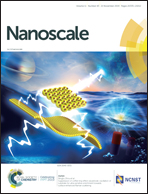Selective ion sieving through arrays of sub-nanometer nanopores in chemically tunable 2D carbon membranes†
Abstract
Two-dimensional (2D) membranes featuring arrays of sub-nanometer pores have applications in purification, solvent separation and water desalination. Compared to channels in bulk membranes, 2D nanopores have lower resistance to transmembrane transport, leading to faster passage of ions. However, the formation of nanopores in 2D membranes requires expensive post-treatment using plasma or ion bombardment. Here, we study bottom-up synthesized porous carbon nanomembranes (CNMs) of biphenyl thiol (BPT) precursors. Sub-nanometer pores arise intrinsically during the BPT-CNM synthesis with a density of 2 ± 1 pore per 100 nm2. We employ BPT-CNM based pore arrays as efficient ion sieving channels, and demonstrate selectivity of the membrane towards ion transport when exposed to a range of concentration gradients of KCl, CsCl and MgCl2. The selectivity of the membrane towards K+ over Cl− ions is found be 16.6 mV at a 10 : 1 concentration ratio, which amounts to ∼30% efficiency relative to the Nernst potential for complete ion rejection. The pore arrays in the BPT-CNM show similar transport and selectivity properties to graphene and carbon nanotubes, whilst the fabrication method via self-assembly offers a facile means to control the chemical and physical properties of the membrane, such as surface charge, chemical nature and pore density. CNMs synthesized from self-assembled monolayers open the way towards the rational design of 2D membranes for selective ion sieving.



 Please wait while we load your content...
Please wait while we load your content...